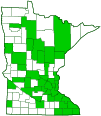eastern yellowjacket
(Vespula maculifrons)
Conservation • Description • Habitat • Ecology • Distribution • Taxonomy
Conservation Status |
|
|||||||
| IUCN Red List | not listed |
|||||||
| NatureServe | NNR - Unranked |
|||||||
| Minnesota | not listed |
|||||||
Description |
||
Eastern yellowjacket is a medium-sized, predatory, social wasp. In eastern North America it is the most common yellowjacket. Adults are ½″ to⅝″ long. The stout body is slightly wider than the head. There are two large compound eyes, one on each side of the head; and three small simple eyes (ocelli) at the top of the head between the compound eyes. The distance between the rear ocellus and the hind margin of the upper surface of the head (vertex) is no more than the diameter of one ocellus. The gap between the jaw (mandible) and the compound eye is narrow, no more than the diameter of one ocellus. The upper (dorsal) space between the compound eyes is entirely black—there is no yellow “eye loop”. There is a yellow band behind the compound eye. It is continuous to the mandible, not interrupted, not narrowed or notched in the middle. The face of the worker is yellow one black spot at the top, one in the center, and two smaller black spots below the center spot. On the face of the queen the top and center spots are joined into a single prominent spot. The face of the male has no spots. The dorsal surface of the thorax (pronotum) is black with no stripes down the middle. A yellow band at the leading edge of the pronotum is interrupted at the apex (nearest to the head). The antennae are long and black. The abdomen of the female has six segments, while that of the male has seven segments. The upper plate (tergum) of each abdominal segment is yellow with black markings. The first tergum has a anchor-shaped basal mark that is at least twice as wide as long and a yellow hind (posterior) margin that is continuous, not broken by black in the middle. On workers and males there are no isolated black spots on tergum 2 through 5. The queen has isolated black spots on tergum 2 through 5 but also has the distinctive anchor-shaped mark on tergum 1. The legs are yellow. The wings are smoky and clear. |
||
Size |
||
Total length: ½″ to ⅝″ |
||
Similar Species |
||
Habitat |
||
|
||
Ecology |
||
Season |
||
Early May through October (CCESR) |
||
Behavior |
||
Workers aggressively defend the nest. They are able to sting multiple times but the barbed stinger sometimes becomes detached in the victim. |
||
Life Cycle |
||
In the spring a queen emerges from hibernation. In early summer she builds an embryonic nest. The papery nest is constructed from wood fibers, plant fibers, cocoon silk, and artificial fibers such as paper, chewed and cemented with saliva. It is usually built underground but may also be built in an stump or attic. It begins as a thin pedicel, a papery disk, and a few hexagonal cells. The queen deposits a single egg into each cell. When the eggs hatch she feeds the young and continues building cells and laying eggs. These first young become workers and take over the care of new young and the expansion of the nest. In late summer the queen begins producing males and new queens. Nest size peaks in August or September. In Minnesota the nests do not survive the winter. Old queens, males, and workers are killed by cold weather in the fall. New queens mate in the fall and then hibernate. |
||
Larva Food |
||
Pre-chewed fragments of caterpillars, other soft-bodied insects, and occasionally carrion. |
||
Adult Food |
||
Plant nectar and the juices of ripe fruit. |
||
Distribution |
||||
|
Sources |
|||
| 12/1/2022 | ||||
Occurrence |
||||
Common and abundant |
||||
Taxonomy |
|||
Order |
Hymenoptera (Ants, Bees, Wasps, and Sawflies) | ||
Suborder |
Apocrita (Narrow-waisted Wasps, Ants, and Bees) | ||
Infraorder |
Aculeata (Ants, Bees, and Stinging Wasps) | ||
Superfamily |
Vespoidea (vespoid wasps) | ||
Family |
Vespidae (hornets, paper wasps, potter wasps, and allies) | ||
Subfamily |
Vespinae (hornets and yellowjackets) | ||
Genus |
Vespula (ground yellowjackets) | ||
| Subgenus | Paravespula | ||
Synonyms |
|||
|
|||
Common Names |
|||
eastern yellowjacket |
|||
Glossary
Ocellus
Simple eye; an eye with a single lens. Plural: ocelli.
Pronotum
The exoskeletal plate on the upper side of the first segment of the thorax of an insect.
Tergum
The upper (dorsal) surface of a body segment of an arthropod. Plural: terga.
Vertex
The upper surface of an insect’s head.
Visitor Photos |
|||||
Share your photo of this insect. |
|||||
| This button not working for you? Simply email us at info@MinnesotaSeasons.com. Attach one or more photos and, if you like, a caption. |
|||||
Alfredo Colon |
|||||
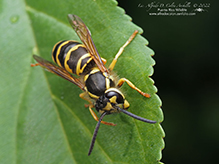 |
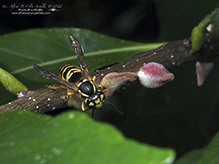 |
||||
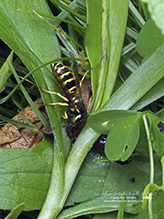 |
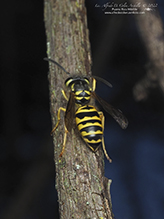 |
||||
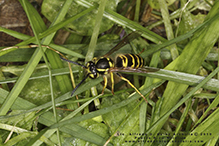 |
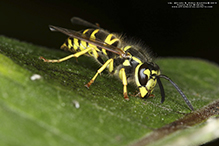 |
||||
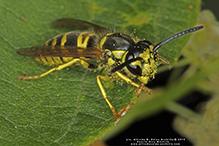 |
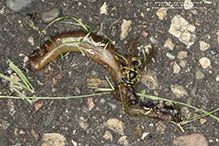 |
||||
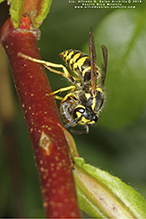 |
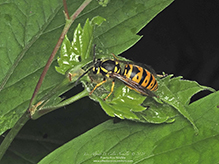 |
||||
Luciearl |
|||||
These bees are eager to take a drink of water when I put out fresh in the afternoon. |
|||||
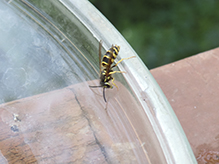 |
|||||
Bill Reynolds |
|||||
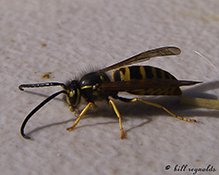 |
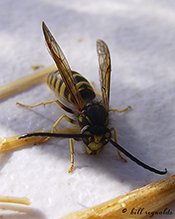 |
||||
MinnesotaSeasons.com Photos |
|||||
|
|||||

Visitor Videos |
|||
Share your video of this insect. |
|||
| This button not working for you? Simply email us at info@MinnesotaSeasons.com. Attach a video, a YouTube link, or a cloud storage link. |
|||
Other Videos |
|||
| Eastern Yellowjacket (Vespidae: Vespula maculifrons) Close-up Carl Barrentine |
|||
About
Uploaded on Sep 17, 2011 Photographed at the Turtle River State Park, North Dakota (17 September 2011). Thank you to 'Vespula vulgaris' (@Bugguide.net) for confirming the identity of this specimen! |
|||
| vespula maculifrons summer101 |
|||
About
Published on Aug 15, 2012 Eastern Yellow Jacket Feeding |
|||
| YELLOW JACKET HORNET VESPULA Maculifrons is the correct name SWIMMER FISH |
|||
About
Uploaded on Jul 28, 2008 i was cutting the grass and got stung 20 times. YELLOW JACKET NEST LIVE VESPULA Maculifrons STING FIRST AID TRAP |
|||
| Eastern Yellowjackets (Vespula maculifrons) Andy Wehrle |
|||
About
Uploaded on Sep 6, 2008 *High quality version is available* A nest of eastern yellowjackets is in the soil between some of the rocks in a short vertical rock wall in our yard. These are closely related to the German yellowjacket (V. germanica) and the aerial yellowjacket (Dolichovespula arenaria). In one scene you can see a yellow-striped caterpillar working on a leaf nearby, he blends right into the neighborhood (probably for his own safety!). |
|||
| SRxthwHcBN4 opannefrank |
|||
About
Uploaded on Jul 13, 2010 A large underground nest belonging to Eastern Yellowjackets is disturbed by a garden hose. The wasps retaliate by swarming the camera, stinging the cameraman and generally having a bad attitude. Also, this did not kill the wasps or cause them to relocate. The next day I poured moth crystals (crushed up moth balls) around the opening of the hive. Within a day or two the wasps had vacated the nest. To my knowledge the crystals didn't kill them (no corpses) just provided a strong deterrent. So, if you're like me and rather not kill these important (yet fucking aggressive and down right nasty) insects, that is a method you can try. In my old age of 24 I've become a bit of a tree hugging liberal softie, I'm afraid. |
|||


Created 7/27/2017
Last Updated:
